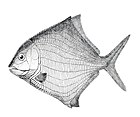How Can We Help?
You are here:
< Back
Extinct genus of fishes


Platysomus (from Greek: πλατύς platys, 'broad' and Greek: σῶμα sôma 'body')[1] is an extinct genus of ray-finned fish that lived in the Carboniferous and Permian periods. Fossils have been found worldwide.
Platysomus was about 18 centimetres (7.1 in) long, and shaped similarly to the discus fish, having the same flattened body and elongated dorsal and anal fins. Its jaws were placed vertically under the braincase, giving it a wide gape. Platysomus is thought to have fed on plankton, and lived in both fresh and salt water.[2]
References
- ^ Roberts, George (1839). An etymological and explanatory dictionary of the terms and language of geology. London: Longman, Orme, Brown, Green, & Longmans. p. 135. Retrieved 30 December 2021.
- ^ Palmer, D., ed. (1999). The Marshall Illustrated Encyclopedia of Dinosaurs and Prehistoric Animals. London: Marshall Editions. p. 35. ISBN 1-84028-152-9.
| Platysomus | |
|---|---|
Categories
-
Annuals36
-
Bulbs, Corms & Tubers41
-
Ferns27
-
Fruits3
-
Garden Plants23
-
Grasses26
-
Herb17
-
Insects1
-
Mammals1
-
Midwest Native Plants0
-
Northeast Native Plants112
-
Perennials123
-
Rose1
-
Shrubs47
-
Trees112
-
Tropical Plants53
-
Upland Birds5
-
Vines18
-
Viola Tricolor1
-
Water Gardening & Plants9
-
Waterfowl0
-
Wetland Birds0
-
Wetland Plants4
-
Wildbirds172
-
Wildflowers1
-
Woodland Plants29
Table of Contents










Recent Comments